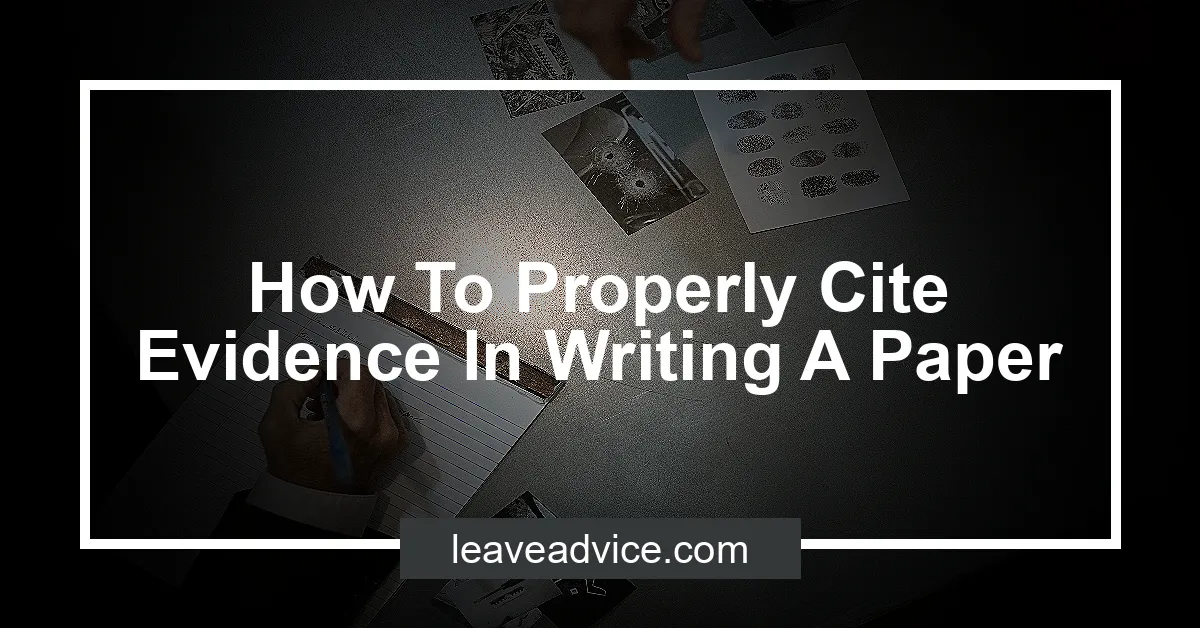How To Properly Cite Evidence In Writing A Paper


Properly citing evidence in writing a paper is crucial to avoiding unintentional plagiarism. Incorrect citations can lead to serious consequences such as a diminished impact of your research and affects on your scholarly evaluation.
The popular citation styles include APA, MLA, and Chicago, and using the appropriate citation style for your field is important. Preventing plagiarism and establishing your credibility as a scholar are just two of the many reasons why citing evidence properly is essential in writing a paper.
Check out this Youtube video: Want to learn how to properly cite evidence in your paper and improve your writing skills? Watch this video for helpful tips and advice!
Understanding Citations
What are citations?
Citations are references included in academic papers to give proper credit to the original authors whose words, ideas, or research are being used. It serves the purpose of acknowledging the sources of information and enables readers to locate the referenced material for further exploration.
In essence, citations enhance the credibility of the writer’s work by demonstrating a well-researched and informed paper.
Different citation styles (APA, MLA, Chicago, etc.)
There are various citation styles including APA, MLA, and Chicago, each with its unique formatting rules for citations and bibliographies. The choice of citation style often depends on the academic discipline or the preference of the instructor or publisher.
For instance, APA style is commonly used in social sciences, MLA in the humanities, while Chicago style is favored in history and publishing. Each style has specific guidelines for citing sources such as books, journals, websites, and other materials, ensuring uniformity and consistency in academic writing.
| Citation Style | Discipline/Usage |
|---|---|
| APA | Social Sciences |
| MLA | Humanities |
| Chicago | History, Publishing |
Understanding citations entails recognizing their importance in academic writing for acknowledging sources and bolstering the credibility of the author’s work. Moreover, comprehending the diverse citation styles, such as APA, MLA, and Chicago, is crucial for adhering to the specific guidelines of each style depending on the academic discipline or the requirements of the paper.
Why Is Proper Citation Important?
Proper citation is crucial in writing to avoid plagiarism, which means using someone else’s work without giving them credit. It is like taking credit for someone else’s genius idea – not cool!
Citing your sources also gives credit to the original authors, acknowledging their hard work and intellectual contributions. This is like saying, “Hey, hats off to you for this brilliant idea!” Moreover, it establishes your credibility as a writer by showing that your arguments are backed by well-researched evidence and not just pulled out of thin air.
It’s like having the receipts to back up your claims – no one can doubt you!
How Do You Cite Evidence Properly in Writing a Paper?
In-text citations
In-text citations are essential for citing evidence within your paper. According to APA citation style, the author’s last name and the year of publication should be used.
For instance, (Field, 2005). When directly quoting, include the page number, such as (Field, 2005, p. 14).
Following the author-date method is crucial for proper in-text citations.
Reference list or bibliography
The reference list should contain all the sources cited in your paper. In APA format, entries include author, date, title, and source, organized accordingly.
These components are critical for creating a comprehensive reference list that supports your paper’s credibility and integrity.
Formatting guidelines for different citation styles
Different citation styles, such as APA and MLA, have specific formatting guidelines. For example, APA format follows the author-date method for in-text citations and utilizes a reference list with specific components.
On the other hand, MLA format uses the author-page method for in-text citations, ensuring the author’s last name and page number are included. Understanding and adhering to the proper formatting guidelines for each citation style are vital for accurately citing evidence in academic papers.
Best Practices for Citing Evidence
Quoting directly vs. paraphrasing
Quoting directly involves using the exact words from the source, enclosed in quotation marks. On the contrary, paraphrasing entails expressing the original idea in your own words while retaining the same meaning.
Utilizing both strategies can add substantial weight and credibility to your paper. Generally, it’s best to paraphrase as it shows a deeper understanding of the material.
For instance, when discussing complex scientific findings, paraphrasing to simplify the content is usually more effective for the reader.
Using signal phrases
Signal phrases play a crucial role in seamlessly integrating evidence into a paper. These short phrases introduce a quote, paraphrase, or summary and signal to the reader that an external source is being utilized.
By incorporating signal phrases, you attribute the supporting evidence to the author, maintain the flow of the essay, and bolster the credibility of your sources. For example, using phrases like “According to…” or “Smith argues that…” helps to attribute information to its rightful source and maintains clarity for the reader.
Being consistent throughout the paper
Consistency is paramount when citing evidence in a paper. It ensures that your writing maintains a cohesive and clear narrative while reinforcing your credibility and authority on the subject matter.
From cited sources to formatting, maintaining consistency prevents confusion and fortifies the overall impact of your work. A simple method of ensuring consistency is to utilize a standardized citation style such as APA or MLA throughout the paper.
This consistency aids in elevating the professional appearance and legitimacy of your writing.
Internal Links
Linking back to previous points or sources within the paper is crucial for providing a seamless reading experience for the audience. It allows readers to navigate through different sections of the paper and refer back to previous information easily.
Properly formatted internal links enhance the overall readability of the paper and enable the audience to comprehend the content more effectively. By incorporating internal links, writers can guide the readers through the logical flow of the information, thereby enhancing their understanding of the topic at hand.
| Pros of Linking | Cons of Linking |
|---|---|
| Facilitates navigation | Risk of overlinking |
| Contributes to coherence | Dilutes the focus |
| Improves reader engagement | Potential distraction |
Enhancing reader understanding of the topic is a key goal of effective internal linking. When utilized strategically, internal links can provide additional context, background information, or related resources that enrich the readers’ comprehension.
Properly linking back to previous points or sources within the paper and formatting them appropriately contributes to the overall quality and accessibility of the content, ultimately benefiting the readers’ understanding of the topic.
I hope this sheds some light on the importance of internal links and their impact on enhancing reader understanding within a paper.
Examples of Proper Citations
Examples of in-text citations
In-text citations in APA style generally include the author’s last name and the year of publication. For instance, a basic in-text citation would look like (Author, Year).
When directly quoting a source, it’s essential to include the page number as well, as in (Author, Year, p. 12). For sources without page numbers, especially web pages and e-books, paragraph numbers are used instead of page numbers.
This format enables the reader to easily identify the source of the information and locate the complete reference in the list of references.
Examples of reference list entries
A reference list entry usually consists of the author’s name, publication date, title, and source. For instance, for a book, the reference entry would typically include the author’s name, the year of publication, the book title, and the source.
The format provides a clear and standardized way to present the complete details of the sources used within the paper. This ensures that readers can easily find and verify the references that have been cited.
Correct formatting for different types of sources
When citing different types of sources, the formatting varies. For example, when citing study notes without a known author, the reference entry would include the title, publication date, and the source.
This allows the reader to understand the specific nature of the source being referenced and provides a complete picture of the cited information. The consistent application of proper formatting enhances the credibility and transparency of the information being presented.
| Types of Sources | Formatting Example |
|---|---|
| Book | Author, A. A. (Year of publication). Title of work: Capital letter also for subtitle. Publisher. |
| Journal Article | Author, A. A., Author, B. B., & Author, C. C. (Year). Title of article. Title of Periodical, volume number(issue number), pages. |
| Website | Author, A. A. (Year, Month Date of publication). Title of web page. Site Name. URL |
The accurate and consistent application of citation formatting is essential for maintaining the integrity and reliability of academic papers and research. It provides a standardized approach to acknowledging the sources of information, thereby upholding the principles of academic honesty and intellectual integrity.
Historical Importance of Citing Evidence
The evolution of citation practices
Citation practices have evolved dramatically with the advent of the digital age, transforming the way we acknowledge and credit sources. From traditional methods to the contemporary Science Citation Index, the practice has continually adapted to the changing landscape of scholarly work.
Famous cases of plagiarism in history
Throughout history, several well-known individuals have been embroiled in plagiarism controversies. Notable cases include Melania Trump’s speech, where similarities to Michelle Obama’s address were pointed out, and even renowned figures like William Shakespeare have faced allegations of literary theft.
How proper citation has shaped academic writing
Proper citation is the cornerstone of academic writing, shaping the construction of credible, well-supported arguments. It not only acknowledges contributors but also adds weight and authority to the author’s assertions, propelling the progress of scholarly discourse and knowledge dissemination.
Counterarguments to Citing Evidence
Arguments against strict citation practices
Strict citation practices can sometimes stifle creativity and original thought, as scholars may be hesitant to share groundbreaking ideas for fear of being held to an overly rigid standard of citation. This can impede the generation of innovative and out-of-the-box thinking, which is essential for the advancement of knowledge and research.
In some cases, a heavy emphasis on citations can overshadow the value of the content itself, leading to a culture of prioritizing quantity over quality.
Addressing common concerns about citations
One common concern about citations is the potential for excessive emphasis on them to overshadow the actual substance and impact of the ideas being presented. This can lead to a situation where the focus shifts away from the essence of the content and towards fulfilling arbitrary citation requirements.
Additionally, strict citation practices can create an environment of fear and anxiety, impacting academic progress by instilling a sense of pressure rather than nurturing genuine academic curiosity and exploration.
Defending the importance of proper citation
While there are valid concerns about the detrimental effects of overly strict citation practices, it’s crucial to recognize the undeniable importance of proper citation in upholding academic integrity and intellectual property rights. By giving due credit to the original sources, proper citation not only acknowledges the contribution of others but also builds a strong foundation of trust and accountability within the scholarly community.
It also promotes a transparent and fair scholarly landscape, ensuring that knowledge is built upon a solid ethical framework.
Statistics on Plagiarism and Citation Practices
Statistics on academic dishonesty
According to a study conducted by Professor Donald McCabe, a staggering 15% of college students submitted fake term papers, while 84% admitted to cheating on written assignments. Shockingly, 52% of students confessed to plagiarizing at least one sentence in their papers.
Alarmingly, 95% of these dishonest acts go undetected, highlighting the pervasive nature of academic dishonesty.
Relevance of proper citation in different fields of study
The importance of proper citation varies across different fields of study. Citing sources is imperative as it strengthens the credibility of research and arguments.
It also allows readers to trace the origins of ideas, fostering transparency and intellectual integrity. In scientific papers, accurate referencing is critical for guiding conclusions, while in social sciences, citation styles provide formal guidelines to avoid plagiarism and uphold academic standards.
Impact of citation on overall academic performance
Proper citation and referencing play a significant role in academic assessment. They not only validate the authenticity of research but also contribute to the overall quality and impact of scholarly work.
Citation counts and related indicators, such as the h-index, are indispensable in assessing research performance. Furthermore, mastering citation practices is essential for graduate students and novice researchers as it influences the evaluation of their academic work.
| Field of Study | Importance of Proper Citation |
|---|---|
| Scientific Research | Guides conclusions, supports arguments, and ensures transparency |
| Social Sciences | Provides formal guidelines, prevents plagiarism, and upholds academic standards |
| Academic Assessment | Validates research, impacts quality, and contributes to the evaluation of scholarly work |
In essence, the statistics on academic dishonesty underscore the prevalence of unethical practices, emphasizing the need for promoting integrity and ethical conduct in education. Moreover, the significance of proper citation transcends disciplinary boundaries, shaping the credibility and impact of academic endeavors.
Mastering citation practices is fundamental for anyone engaging in scholarly pursuits, emphasizing the crucial role of accurate referencing in academic and research contexts.
Definitions of Key Citation Terms
An in-text citation is a brief reference within the body of your work that acknowledges the source of your information, usually including the author’s last name and publication date or page number. It helps readers identify the original source of the information you are presenting.
This is vital for ensuring academic integrity and avoiding plagiarism.
A bibliography, on the other hand, is a comprehensive list of all the sources you have used in your research and writing. It is typically included at the end of your paper and provides detailed information about each source, allowing readers to locate and verify the references.
Quoting involves directly incorporating the words of another author into your writing. It is important to use quotation marks and provide clear attribution to the original source when including verbatim quotes in your paper.
One commonly misunderstood citation term is plagiarism, which occurs when you use someone else’s ideas, words, or work without giving them proper credit. Plagiarism can have serious consequences in academic and professional contexts, so it’s crucial to understand how to cite evidence properly in writing a paper to avoid this issue.
Anecdotes About Common Citation Mistakes
Once upon a time, a student confidently cited a witty anecdote found in an old book, only to realize later that the book had misattributed the story to Mark Twain. As it turned out, Twain had never written it!
The student’s error got the class laughing, but it was a lesson well-learned about the dangers of blindly trusting sources.
Quotes About the Importance of Proper Citation
“No research without action, no action without research” – Kurt Lewin
“Citations fuel literature reviews and allow researchers to link their experiments to previous results.” – Significance and implications of accurate and proper citations (NCBI)
“Good writing is supposed to evoke sensation in the reader – not the fact that it is raining, but the feeling of being rained upon.” ― E. L. Doctorow (falconediting.com)
“Good citation practices make you a better writer. All of us aspire towards that elegant paper in which the prose is as compelling as the content and good attribution habits build a strong foundation towards that goal.” – 6 Reasons Why Citation of Sources is Important When Writing
“Education is not the filling of a pot but the lighting of a fire.” – W. B. Yeats
“A teacher is one who makes himself progressively unnecessary.” – Thomas Carruthers
Internal Links in Academic Writing
Internal links play a crucial role in guiding readers through a paper by directing them to related information within the same website. By strategically placing internal links, writers can enhance the flow of information, allowing readers to seamlessly navigate through different sections of a paper, thus improving overall coherence and readability.
Recommended Amazon Products for Properly Citing Evidence in Writing a Paper
Here’s a curated list of products that can help you properly cite evidence in writing a paper with ease. These recommendations are based on functionality, price, and reviews.
Casio FX-115ES PLUS Scientific Calculator
The Casio FX-115ES PLUS Scientific Calculator is a great tool for accurately performing mathematical calculations when gathering data for your research. With its multi-replay function, you can go back step-by-step through calculations to verify results, making it a valuable asset for accurate data analysis. Check it out on Amazon.


| Pros | Cons |
|---|---|
| Allows for complex calculations | May not be necessary for all research projects |
| Dual power capability (solar and battery) | Learning curve for utilizing all functions |
| Approved for use on various standardized tests |
Sharpie Pocket Highlighters
Sharpie Pocket Highlighters are essential for marking key points and references within research materials. The vibrant colors of these highlighters are designed to stand out on the page, making it easy to identify important information for citation and reference purposes. Check it out on Amazon.


| Pros | Cons |
|---|---|
| Smear Guard ink reduces smudging | May bleed through thin paper |
| Includes a chisel tip for broad and fine lines | Potential for drying out quickly |
| Compact, portable design |
Oxford Ruled Index Cards
Oxford Ruled Index Cards provide a convenient way to jot down crucial information for citing sources or making note of key details during the research process. Their compact size makes them ideal for creating flashcards to aid in memorizing important details for your paper. Check it out on Amazon.


| Pros | Cons |
|---|---|
| 100 cards per pack for ample note-taking | Potential to get lost due to small size |
| Ruled lines for organized writing | May not be suitable for more extensive notes |
| Durable paper for long-term use |
Post-it Flags
Post-it Flags are perfect for marking specific pages and passages in books or articles that you plan to reference in your paper. The different colored flags help categorize and prioritize your sources, making it easier to locate and organize your references during the writing process. Check it out on Amazon.


| Pros | Cons |
|---|---|
| Easy to remove and reposition | Adhesive may lose stickiness over time |
| Writable surface for notes | Limited quantity in each pack |
| Helps with quick source identification |
Top Recommended Product for Properly Citing Evidence in Writing a Paper
If you’re looking for the best solution for properly citing evidence in writing a paper, we highly recommend the Casio FX-115ES PLUS Scientific Calculator. This scientific calculator’s functionality, reliability, and overall value make it an essential tool for accurate data analysis and mathematical calculations during the research process. With its multi-replay function and dual power capability, the Casio FX-115ES PLUS Scientific Calculator is a top choice for researchers aiming to maintain precision and credibility in their work. Ready to improve your citations? Check out the Casio FX-115ES PLUS Scientific Calculator today for the best results!


Conclusion
Citing evidence properly in writing a paper is crucial to acknowledge the sources of information and give credit to the original authors.
Additionally, it helps to support the credibility of your own argument and avoid plagiarism. Proper citation also allows readers to locate the original sources for further reading and verification of the information provided in the paper.
Following the specific citation style guidelines, such as APA, MLA, or Chicago, is important in ensuring consistency and accuracy in citing evidence throughout the paper. It is also essential to provide in-text citations and a corresponding list of references or works cited at the end of the paper to fully acknowledge the sources used in the research and writing process.
















